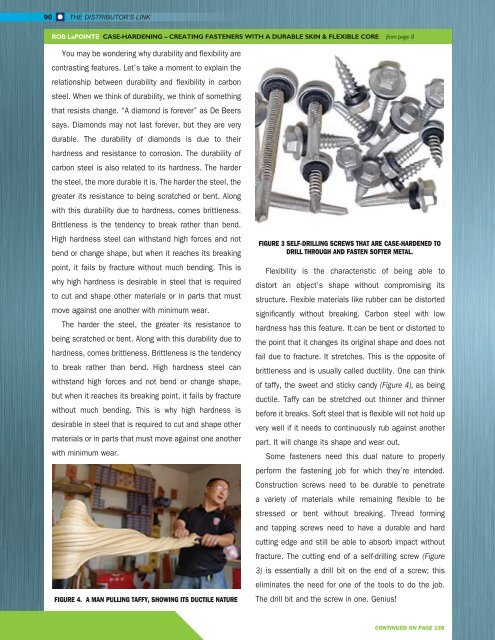WINTER 2024
Distributor's Link Magazine Winter 2024 / Vol 47 No 1
Distributor's Link Magazine Winter 2024 / Vol 47 No 1
You also want an ePaper? Increase the reach of your titles
YUMPU automatically turns print PDFs into web optimized ePapers that Google loves.
90<br />
THE DISTRIBUTOR’S LINK<br />
ROB LaPOINTE CASE-HARDENING – CREATING FASTENERS WITH A DURABLE SKIN & FLEXIBLE CORE from page 8<br />
You may be wondering why durability and flexibility are<br />
contrasting features. Let’s take a moment to explain the<br />
relationship between durability and flexibility in carbon<br />
steel. When we think of durability, we think of something<br />
that resists change. “A diamond is forever” as De Beers<br />
says. Diamonds may not last forever, but they are very<br />
durable. The durability of diamonds is due to their<br />
hardness and resistance to corrosion. The durability of<br />
carbon steel is also related to its hardness. The harder<br />
the steel, the more durable it is. The harder the steel, the<br />
greater its resistance to being scratched or bent. Along<br />
with this durability due to hardness, comes brittleness.<br />
Brittleness is the tendency to break rather than bend.<br />
High hardness steel can withstand high forces and not<br />
bend or change shape, but when it reaches its breaking<br />
point, it fails by fracture without much bending. This is<br />
why high hardness is desirable in steel that is required<br />
to cut and shape other materials or in parts that must<br />
move against one another with minimum wear.<br />
The harder the steel, the greater its resistance to<br />
being scratched or bent. Along with this durability due to<br />
hardness, comes brittleness. Brittleness is the tendency<br />
to break rather than bend. High hardness steel can<br />
withstand high forces and not bend or change shape,<br />
but when it reaches its breaking point, it fails by fracture<br />
without much bending. This is why high hardness is<br />
desirable in steel that is required to cut and shape other<br />
materials or in parts that must move against one another<br />
with minimum wear.<br />
FIGURE 4. A MAN PULLING TAFFY, SHOWING ITS DUCTILE NATURE<br />
FIGURE 3 SELF-DRILLING SCREWS THAT ARE CASE-HARDENED TO<br />
DRILL THROUGH AND FASTEN SOFTER METAL.<br />
Flexibility is the characteristic of being able to<br />
distort an object’s shape without compromising its<br />
structure. Flexible materials like rubber can be distorted<br />
significantly without breaking. Carbon steel with low<br />
hardness has this feature. It can be bent or distorted to<br />
the point that it changes its original shape and does not<br />
fail due to fracture. It stretches. This is the opposite of<br />
brittleness and is usually called ductility. One can think<br />
of taffy, the sweet and sticky candy (Figure 4), as being<br />
ductile. Taffy can be stretched out thinner and thinner<br />
before it breaks. Soft steel that is flexible will not hold up<br />
very well if it needs to continuously rub against another<br />
part. It will change its shape and wear out.<br />
Some fasteners need this dual nature to properly<br />
perform the fastening job for which they’re intended.<br />
Construction screws need to be durable to penetrate<br />
a variety of materials while remaining flexible to be<br />
stressed or bent without breaking. Thread forming<br />
and tapping screws need to have a durable and hard<br />
cutting edge and still be able to absorb impact without<br />
fracture. The cutting end of a self-drilling screw (Figure<br />
3) is essentially a drill bit on the end of a screw; this<br />
eliminates the need for one of the tools to do the job.<br />
The drill bit and the screw in one. Genius!<br />
CONTINUED ON PAGE 138
















